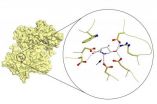(Press-News.org) AMHERST, Mass. – A research team led by biochemist Scott Garman at the University of Massachusetts Amherst has discovered a key interaction at the heart of a promising new treatment for a rare childhood metabolic disorder known as Fabry disease. The discovery will help understanding of other protein-folding disorders such as Alzheimer's, Parkinson's and Huntington's diseases, as well. Findings are featured as the cover story in the current issue of Chemistry & Biology.
People born with Fabry disease have a faulty copy of a single gene that codes for the alpha-galactosidase (α-GAL) enzyme, one of the cell's "recycling" machines. When it performs normally, α-GAL breaks down an oily lipid known as GB3 in the cell's recycling center, or lysosome. But when it underperforms or fails, Fabry symptoms result. Patients may survive to adulthood, but the disorder leads to toxic lipid build-up in blood vessels and organs that compromise kidney function or lead to heart disease, for example.
The faulty gene causes its damage by producing a misfolded protein, yielding an unstable, poorly functioning α-GAL enzyme. Like origami papers, these proteins are unfolded to start and only become active when folded into precise shapes. At present, enzyme replacement therapy (ERT) is the only FDA-approved treatment for such lysosomal storage disorders as Fabry, Pompe and Gaucher diseases, but ERT requires a complicated and expensive process to purify and replace the damaged α-GAL enzyme, and it must be administered by a physician.
Instead of replacing the damaged enzyme, an alternative route called pharmacological chaperone (PC) therapy is currently in Phase III clinical trials for Fabry disease. It relies on using smaller, "chaperone" molecules to keep proteins on the right track toward proper folding, but their biochemical mechanism is not well understood, says Garman.
Now, he and colleagues report results of a thorough exploration at the atomic level of the biochemical and biophysical basis of two small molecules for potentially stabilizing the α-GAL enzyme. He says their use in PC therapy could one day be far less expensive than the current standard, ERT, and can be taken orally.
This work, which improves knowledge of a whole class of molecular chaperones, represents the centerpiece of UMass Amherst student Abigail Guce's doctoral thesis and was supported by the National Institutes of Health. Other members of the team are graduate students Nat Clark and Jerome Rogich.
"The interactions we looked at are exactly the things occurring in the clinical trial right now," Garman says. Further, "the same concept is now being applied to other protein-folding diseases such as Parkinson's and Alzheimer's disease. Many medical researchers are trying to keep proteins from misfolding by using small chaperone molecules. Our studies have definitely advanced the understanding of how to do that."
In their current paper, Garman and colleagues compare the ability of two small chaperone molecules, galactose and 1-deoxygalactononjirimycin (DGJ) to stabilize the α-GAL protein, to help it resist unfolding in different conditions such as high temperature and different pH levels.
They found that each chaperone has very different affinities: DGJ binds tightly and galactose binds loosely to the α-GAL, yet they differ in only two atomic positions. "Tight is better, because you can use less drug for treatment," Garman says. "We now can explain DGJ's high potency, its tight binding, down to individual atoms."
In earlier studies as in the current work, the UMass Amherst team used their special expertise in X-ray crystallography to create three-dimensional images of all atoms in the protein to understand how it carries out its metabolic mission. They also found a new binding site for small molecules on human α-GAL that had never been observed before.
Crystallography on the two chaperones bound to the α-GAL enzyme showed that a single interaction between the enzyme and DGJ was responsible for DGJ's high affinity for the enzyme. Other experiments also showed the ability of the 11- and 12-atom chaperones to protect the large, 6,600-atom α-GAL from unfolding and degradation.
For the first time, by making a single change in one amino acid in protein, they forced the DGJ to bind weakly, indicating that one atomic interaction is responsible for DGJ's high affinity.
"It was surprising to find these two small molecules that look very much the same have very different affinities for this enzyme," says Garman, "and we now understand why. The iminosugar DGJ has high potency due to a single ionic interaction with α-GAL. Overall, our studies show that this small molecule keeps the enzyme from unfolding, or when it unfolds, the process happens more slowly, all of which you need in treating disease."
INFORMATION:
The UMass Amherst team plans to next use the principles, assays and experiments they developed here on enzymes defective in other human diseases to examine new therapies for them and related disorders.
A figure summarizing the interactions is available at: www.umass.edu/newsoffice/
Biochemists develop promising new treatment direction for rare metabolic diseases
2011-12-23
ELSE PRESS RELEASES FROM THIS DATE:
UT-ORNL research reveals aquatic bacteria more recent move to land
2011-12-23
Research by University of Tennessee, Knoxville, faculty has discovered that bacteria's move from sea to land may have occurred much later than thought. It also has revealed that the bacteria may be especially useful in bioenergy research.
Igor Jouline, UT-Oak Ridge National Laboratory joint faculty professor of microbiology and researcher at ORNL's Joint Institute for Computational Sciences, performed a genome sequence analysis of the soil bacteria Azospirillum, a species' whose forbearers made the sea-to-land move. The analysis indicates the shift may have occurred ...
Long intervening non-coding RNAs play pivotal roles in brain development
2011-12-23
FINDINGS: Whitehead Institute scientists have identified conserved, long intervening non-coding RNAs (lincRNAs) that play key roles during brain development in zebrafish, and went on to show that the human versions of these RNAs can substitute for the zebrafish lincRNAs.
RELEVANCE: Despite their prevalence in the cell, lincRNAs have been referred to as the "dark matter" of all the transcribed RNAs because little is known of their functions or mechanisms. Until now, lincRNAs have been studied primarily in cell lines rather than at the organismal level, which has precluded ...
Unnatural disasters
2011-12-23
Global wildlife is facing an unprecedented threat from natural disasters exacerbated by climate change, warn scientists in a paper published in Trends in Ecology and Evolution.
Hurricanes, droughts, flooding and wildfires are predicted to increase in frequency and severity – but despite being able to spot human populations at risk, there is currently no mechanism for identifying vulnerable animal populations.
Now scientists from the Zoological Society of London (ZSL) have come up with a method to identify populations likely to experience drastic changes in their population ...
NIH researchers uncover clues related to metal-on-metal hip implants
2011-12-23
A new study, bringing together an interdisciplinary team of physicians and engineers from the United States and Germany, made a surprising finding about implants used in hip replacement surgery: Graphite carbon is a key element in the lubricating layer that forms on metal-on-metal hip implants. The lubricant has more in common with the lubrication of a combustion engine than that of a natural joint. The study was funded by the National Institute of Arthritis and Musculoskeletal and Skin Diseases (NIAMS), part of the National Institutes of Health.
Made possible by an ...
Carlsbad Mayor, CDOD: Positive News About WIPP 2012 Budget
2011-12-23
Members of New Mexico's congressional delegation have shown their strong support of the Waste Isolation Pilot Plant's safety record and operational success by fighting to keep the Department of Energy facility sufficiently funded.
The Waste Isolation Pilot Plant, or WIPP, is the Department of Energy's underground repository for defense-generated, transuranic (TRU) waste. Since WIPP opened in 1999, more than 10,000 shipments of TRU waste have been permanently disposed of in salt beds 2,150 feet below the surface. WIPP is located about 26 miles outside of Carlsbad, New ...
'Nanoantennas' show promise in optical innovations
2011-12-23
WEST LAFAYETTE, Ind. – Researchers have shown how arrays of tiny "plasmonic nanoantennas" are able to precisely manipulate light in new ways that could make possible a range of optical innovations such as more powerful microscopes, telecommunications and computers.
The researchers at Purdue University used the nanoantennas to abruptly change a property of light called its phase. Light is transmitted as waves analogous to waves of water, which have high and low points. The phase defines these high and low points of light.
"By abruptly changing the phase we ...
New Dabota Chairs and Skidmore Chairs From Rattanland
2011-12-23
RattanLand, a Company specializing in the import and export of home furniture, has new products to offer to its customers worldwide - Dabota Chairs and Skidmore Chairs.
New Skidmore and Dabota Chairs
The Company is proud to announce two new products that have been added to its already impressive product range - Skid and Dabota chairs.
Skidmore chairs are classic looking chairs that come with a simple design. There are no armrests, and the chairs sit on four legs each. These chairs are ideal for the outdoor garden or porch.
Dabota chairs also come in a simple ...
Blood progenitor cells receive signals from niche cells and the daughter blood cells they create
2011-12-23
Maintaining balance is crucial. In Drosophila, the common fruit fly, the creation and maintenance of the blood supply requires such balance.
UCLA stem cell scientists have now uncovered that two-way signaling from two different sets of cells is necessary for that balance, both to ensure enough blood cells are made to respond to injury and infection and that the blood progenitor cell population remains available for future needs.
The stem cell-like blood progenitor cells – which contribute to the cells of the adult fruit fly's blood supply – receive signals from cells ...
Defending the genome
2011-12-23
WORCESTER, Mass. – Small, mobile sequences of DNA left over from viruses, called transposons or "jumping genes" because of their ability to move around the genome, pose a significant threat to the genetic integrity and stability of an organism. Considered genetic parasites, these transposable elements are believed to comprise as much as 50 percent of the human genome. Because of the damage transposons can do to an organism's DNA, an immune-like response has evolved to turn off, or silence, these mobile genetic elements.
New research published in the journal Cell by the ...
UNC HIV prevention research named scientific breakthrough of the year
2011-12-23
CHAPEL HILL, N.C. – The HIV Prevention Trials Network 052 study, led by Myron S. Cohen, MD of the University of North Carolina at Chapel Hill, has been named the 2011 Breakthrough of the Year by the journal Science.
HPTN 052 evaluated whether antiretroviral drugs can prevent sexual transmission of HIV among couples in which one partner has HIV and the other does not. The research found that early treatment with antiretroviral therapy reduced HIV transmission in couples by at least 96 percent.
The study was funded by the National Institute of Allergy and Infectious Diseases, ...


